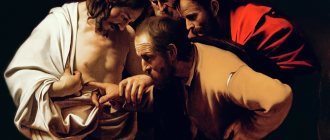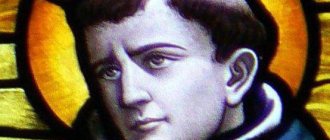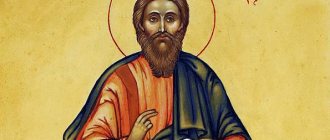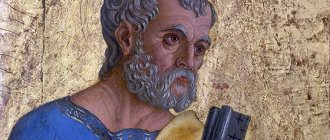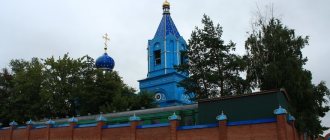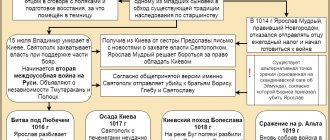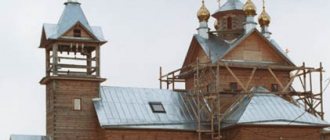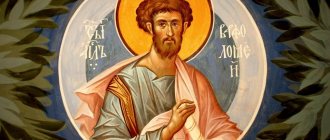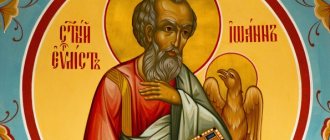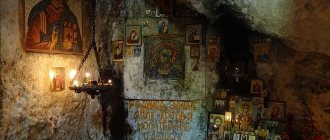The Apostle Thomas is not as famous as Peter or Paul. Many people only know about him that he was temporarily an “unbeliever.” Who was this student really? What valuable lesson can modern Christians learn from his life?
Apostle Thomas.
From the collection of N.P. Likhachev (No. III–315), from where it entered the Russian Museum in 1913. Life of the Apostle Thomas
His homeland is the Galilean city of Pansady. His professional activity was fishing. Having met the Anointed One of God, Thomas followed him and abandoned his usual way of life, becoming one of the 12 apostles.
Like the rest of Christ's closest followers, he followed his Teacher everywhere. After the resurrection of Christ, Thomas expressed doubt about the reliability of reports about this greatest event in history. However, as soon as he regained faith in Jesus as his Savior, Thomas became one of the most zealous Christian missionaries. He founded churches in Palestine, Parthia, Mesopotamia, and Ethiopia. In his zealous service, Thomas even reached India, where he died.
“Thomas, who was once weaker than the other apostles in the faith, became by the grace of God more courageous, zealous and tireless than all of them, so that he went around almost the entire earth with his preaching, not being afraid to proclaim the Word of God to the savage peoples.”
John Chrysostom
Why is Apostle Thomas called a twin?
From the Hebrew language the name of the companion of Jesus is translated as “to be divided in two, in half.” For this reason he was called the Gemini. In Greek his name sounded like Didim. The Gnostics came to the conclusion that Thomas was almost a copy of Christ himself in appearance. But there is no biblical basis for such an opinion.
Biblical scholar Lopukhin notes that it would be more correct to translate Thomas’ nickname as “Man of Double Nature.”
We are talking about someone who constantly moves from one state of mind to another, whose thoughts are double. Was the Apostle Thomas truly an “unbeliever”?
Why did Thomas not believe the message of the apostles that they had seen the risen Christ? There is a good lesson in this for all who are awaiting the Second Coming of our Lord.
It may seem surprising that for Christ’s closest associates, his resurrection became something of a sensation. He came to life as promised. Why did they all doubt this, and Thomas showed the most “blatant” disbelief, declaring that until he put a finger into his wounds, he would not believe that the Lord had come to life?
The Unbelief of the Apostle Thomas (Italian: Incredulità di San Tommaso) is a painting by Caravaggio based on the Gospel story.
The fact is that the Jews were expecting the Messiah, who would become the new David and Solomon. His “responsibilities” included:
- Take the royal throne in Jerusalem.
- Free Israel from the power of the pagans.
- Make Jews rulers of the world.
This is what the Jews absorbed with their mother's milk while studying the prophecies of the Old Testament. Unfortunately, almost no one paid due attention to the predictions about the suffering and death of the Messiah.
For this reason, the apostles did not believe Jesus when he spoke of his sacrificial death. They thought he was joking or perhaps testing their loyalty. But when the Lord actually died, their expectations were dashed and they were deeply disappointed. This happened to Thomas too. Habitual expectations and fear of new pain prompted him to doubt the words of the apostles about the resurrection of the Teacher. But after the appearance of the Teacher, everything changed:
“After eight days His disciples were again in the house, and Thomas was with them. Jesus came when the doors were locked, stood in the midst of them and said: Peace be with you!
Then he says to Thomas: put your finger here and see my hands; give me your hand and place it in my side; and do not be an unbeliever, but a believer.
Thomas answered Him: My Lord and my God!
Jesus says to him: You believed because you saw Me; Blessed are those who have not seen and yet have believed.”
(John 20:26-29)
With these words, Christ did not encourage us to blind faith. He wanted to say that there was more than enough evidence to believe in him even without his visible presence.
“...in the Lord’s pleasing of those who will believe in Him without seeing Him - Jesus Christ, of course, had in mind here the Christians of future times - lies a gentle reproach to Thomas for wanting to have more tangible evidence of the resurrection of Christ than what he deigned to give to people God".
Bible scholar Lopukhin
the icon “The Assurance of Thomas” participates in the service for Antipascha The mission of the Apostle Thomas in India
The life of Thomas after farewell to the Teacher is described in the non-canonical work “The Acts of the Apostle Thomas,” dating from the 2nd–3rd centuries. ad. He went to India as a result of the delimitation of lands between the apostles for preaching service.
In the new country he continued active preaching. According to legend, Thomas hired himself into the service of the Indian ruler Gundofar as a carpenter to build a palace. But the apostle - instead of fulfilling the order - distributed the money to the poor.
“The palace had not been built, he had not done anything yet, but he went around the cities and villages, gave to the poor and taught them about the new God, and also healed illnesses, cast out demons and accomplished many things. And we think that he is a sorcerer; but his compassion, his healing, which were free of charge, and his asceticism, and his piety make us think of him that he is a magician or a messenger of that new God.”
(Acts of Thomas)
The king was angry and ordered the carpenter to be arrested. He would have executed him if his brother had not appeared to him in a dream, saying that the most wonderful house was waiting for him in heaven, the builder of which was Thomas. The execution was canceled.
Interesting fact
In 1834, coins depicting King Gundofar were found in a valley in Afghanistan near Kabul.
Coins of the Indo-Parthian king Gondophares.
Execution and death of the Apostle Thomas
In Melipura, a zealous missionary converted to Christianity the life partner and son of a ruler named Mazdeus. When the king found out about this, he angrily ordered the arrest of the preacher of the new faith. But the king’s relatives visited the disciple Jesus so that he would baptize them. The Apostle, like Peter before him, left prison. But then he returned, after which he was able to give testimony about Christ to the king. When asked about his Master, the faithful disciple replied that Jesus is the Master of the entire planet.
Mazdey, despite the protests of his subjects, ordered the execution of the bearer of new ideas. On the way to the place of execution, Thomas appointed Sephorus as a presbyter and the king’s son as a deacon. He was pierced by spears in 72 or 73 AD. At this point, Didim had been in India for about 27 or 28 years. After his death, the king himself and his officials became followers of Christ.
The Day of Remembrance of the Apostle Thomas is celebrated by the Orthodox on October 19.
Apostle Thomas.
Late XIX - early XX centuries. Wood, tempera. Relics of the Apostle Thomas
The relics of the Apostle are kept:
- In the Indian city of Chennai in a temple built in honor of the apostle.
- In the monastery dedicated to John the Theologian on the Greek island of Patmos.
- In the Italian city of Orton in the Catholic Basilica of St. Thomas the Apostle.
- In Hungary.
- On Athos.
- In Georgian Tbilisi.
What do they pray to this saint for?
Orthodox Christians turn to Thomas to strengthen their faith in the existence of God and the fulfillment of His promises. It is especially important to turn to Thomas for help on those days when a person experiences deep disappointment on his spiritual path. Christians also pray that Thomas will help unbelieving family and friends find a strong connection with God.
Apostle Thomas is a wonderful example of sincere love for the Lord Jesus Christ. At the same time, his doubt contains a valuable lesson for us. From time to time we should examine how our religious expectations correspond to the truth set forth in the Holy Scriptures. Then we will not be disappointed.
Author Victor Glebov
Biography of the Apostle Thomas
In the main source of biblical history - the Holy Scriptures - the name of Thomas is mentioned several times. The bulk of information about his life is presented in the apocryphal work “The Acts of Thomas.”
Saint Thomas the Apostle
Thomas was born in the city of Peneas, located on the shores of the Sea of Galilee. The Gospel says that he was a fisherman, and according to other sources, he was a carpenter and builder. Impressed by the preaching of Jesus, the young man left his work and followed the Teacher, who called him to the ranks of his disciples.
More about the apostles:
- Holy Chief Apostle Peter
- Icon of the Apostle John the Theologian
- Prayer to Saint Apostle Philip
Origin of the phrase "Doubting Thomas"
The main episode involving the Apostle Thomas is the story of his assurance of the resurrection of Jesus Christ.
Didymus was one of the most devoted disciples of Christ. He firmly believed that the Teacher would lead them to the Kingdom of God. However, he did not get rid of the fear of physical death. Therefore, he grieved the death of Jesus on the cross. Perhaps this is due to his absence during the first appearance of the Savior to the disciples after the resurrection.
In response to the good news, he replied that he would believe in a joyful event only when he saw the wounds from the nails and put his fingers into them. After 8 days, Jesus appeared to him and offered to touch his wounds. After this, Didim exclaimed: “My Lord and my God!” The Son of God reproached him for his unbelief. This event made the phrase “Doubting Thomas” a household phrase.
Icon "Belief of Thomas"
Apostle Thomas.
Novgorod school 60s. XIV century Bright Week ends with St. Thomas' Resurrection, which is, as it were, a replacement (repetition) of Easter Day itself, which is why it is also called Antipascha (translated from Greek - “instead of Easter”). The service of this day is devoted mainly to the remembrance of the appearances of Christ after the Resurrection to the Apostles, including Thomas. The entire service encourages believers to awaken from their sinful sleep, turn to the Sun of Truth - Christ, strengthen their faith and, together with the ap. Thomas sincerely and joyfully exclaim: “My Lord and my God.” On Saturday evening before 9 o'clock the royal gates are closed. The 9th hour reads the usual three-psalm. On it is the Sunday troparion in the 8th tone: From on high you came down and the kontakion of Easter: Even into the grave. On Antipascha Week, Sunday hymns from the Octoechos are not sung; the entire service will be performed according to the Colored Triodion. Starting from St. Thomas Sunday, the verses of the Psalms, polyeleos and other sequences are resumed at services. The usual structure of the all-night vigil, hours, and Liturgy is restored (with the exception of some features). From this day until Easter is celebrated, at all services that begin with the exclamation of the priest, and also before the start of the Six Psalms, Christ is Risen is sung or read three times. Since ancient times, the eighth day after Easter, as the end of Bright Week, was celebrated especially, it was, as it were, a replacement for Easter, which is why it was called Antipascha, which means instead of Easter. On this day, the memory of the Resurrection of Christ is renewed, which is why Antipascha is also called the week of renewal. Since the renewal of the resurrection of Jesus Christ was especially for the sake of the Apostle Thomas, who was not present in the events of the Resurrection of the Savior and did not believe in it, it was to him that the evidence of the Resurrection was revealed. In this regard, the week is also called Fomina. The Church attaches special significance to this event. Thomas was born on April 2, 7 BC. in northern India, his parents were engaged in cattle breeding and had a huge family of 15 people (Thomas was the fourth child). Outwardly, Thomas was very different from the other students - dark curly hair, black eyes, dark skin. Among the apostles, Thomas felt like a stranger, so he communicated with few of them, trying to be alone as much as possible. Thanks to the gospel stories, the expression “Doubting Thomas” became a household word. Foma really looked critically at the world around him, trying not to trust the first impression, he clarified and double-checked everything. But having convinced himself of the truth of what had happened, he believed completely and irrevocably. Thomas is the only one of the disciples who was never married. He left his parents' home at the age of 12 and went to travel the world. Jesus walked along the east coast of India along the Bay of Bengal from the Ganges River to the Krishna River. Near the modern city of Hyderabad, Jesus met the future apostle Thomas. Thomas, carried away by the preaching of Jesus, became his disciple and follower. Jesus and Thomas crossed India from east to west and arrived in the city of Bombay. From here they headed to Judea. The very first disciple of Jesus was actually the Indian Thomas. He joined the teacher in India and since then has not parted with him - he came to Judea with Jesus and accompanied him on all his travels. Only one apostle did not see the risen Christ - Thomas. The other disciples told him: “We have seen the Lord.” But he answered them: “Until I see the wounds on his hands, and put my finger, and put my hand into his side, I will not believe.” Having told the disciples to go to Galilee, Jesus himself went to Bethany to Lazarus and met his mother there. Meanwhile, by order of Caiaphas, Joseph of Arimathea was arrested. Joseph was kept under arrest for three days and released because they did not know what exactly he could be accused of. Caiaphas believed that the rumors about the resurrection of Christ were false. It is unclear what Joseph had to do with these rumors. Therefore, Joseph was released, but just in case, they put him under surveillance. But since the suspect did not meet with anyone and no one came to his house, the surveillance was soon lifted. It was dangerous for Jesus to be in Jerusalem. He went to Galilee, his homeland, to see all his people there.
The Assurance of Saint Thomas (painting by Caravaggio, 1601-1602). In the painting, Thomas is depicted touching the wounds of Christ.
Second Appearance to the Disciples: Thomas the Unbeliever
For safety reasons, movement was only possible at night. Jesus was to be accompanied on the journey by two young men. One is the son of Joseph of Arimathea, the second is his nephew, the son of his elder brother. Both boys loved Jesus very much. Jesus walked alone, and two boys followed him at a distance so that the large group of people would not attract attention on the night road. It took Jesus three days to reach his friends in Galilee. He stayed here for about a week, resting. Then the Teacher appeared to people again to see his mother and family. The second time Jesus appeared to the disciples was eight days after the first. Now Thomas, an unbeliever, was with them. Jesus said to Thomas: “Put your finger here and look at my hands, put your hand in my side and don’t be an unbeliever, but become a believer.” Thomas answered him: “My Lord and my God!” Jesus says to him: “You believed because you saw me.” Happy will be those who did not see, but believed.
He said to his disciples: “I will leave soon.” I will ascend to Heaven and you will never see me again. He again accused them of lack of faith. The fact is that they were never truly loyal to him. But he is still grateful to them for the lesson he learned from them. The students stood in front of him, confused and embarrassed. They felt uncomfortable and ashamed. Jesus said: “If I accepted such a martyr’s death, then each of you will accept exactly the same death.” Because when we were one flock and I was your shepherd, we could defeat the wolf. And now, when we are left each on our own, you will accept the same martyrdom as I did. You cannot remain any longer in Judea, because you will be severely persecuted. Cast lots as to who should go where, in which direction to carry the Word of God. The apostles did as Jesus advised them - they cast lots to determine who would go to which country. Our Lady Mary also took part in the draw, and she got Georgia. But at the last moment, Jesus appeared to the Mother of God and said that it was not worth going to Georgia. Mary will have to go to Gaul (France). Joseph of Arimathea and Nicodemus were preparing to leave Judea and leave forever for distant Gaul.
Rembrandt. doubting Thomas
After the crucifixion and resurrection of Jesus Christ, the apostle returned to his homeland and preached in South India. Built the palace of Gondofer. The king of the province in which Thomas stayed was very progressive, he loved to talk with the disciple of Jesus, he liked a lot about this man, especially his stories, which were like a fairy tale. But Thomas not only had conversations with the king, he preached, and successfully, many liked his sermons, especially the poor. Thomas was imprisoned for preaching. But while he was sitting, the king had a vision. His dead mother came to him and said: “Release the man sitting in your dungeon, and show him honor, accept his faith, otherwise you will lose the most precious thing you have.” The king did not even doubt what was said, since there was only one person in the dungeon - Thomas, and the most precious thing that the king had was his only son. Three daughters didn't count. Well, he had no doubt that his mother had appeared to him, since from childhood anyone, even a child, knew about life after death and the request of the deceased was a law for the living, which was impossible to contradict. Foma was released that same evening. Two weeks later the king was baptized. And in honor of the Apostle Thomas, a year later he built a palace like a church. Here, a disciple of Jesus Christ wrote his Gospel, but he wanted to convey the faith of Jesus Christ to those who took his life, he wanted everyone to understand what the world had and what it had lost. In 34 he goes to Rome to convey the Gospel to the Roman priests. In Rome, they already knew about Jesus and his disciples, since messages came from one place or another about their deeds, Rome did not like this terribly, so they were persecuted. They also did not like the content of what Thomas conveyed; he was persecuted, and he was forced to leave Rome again to India through Asia Minor, Syria and Persia. The Gospel remained in Rome until 325. Thomas in India traveled through many kingdoms, preaching and healing, being persecuted from almost everywhere.
According to legend, the founder of Christianity in India, preaching in the city of Meliapore (Malipur), located on the eastern coast of the Hindustan Peninsula, was accused by a pagan priest of killing his son for the death of the young man. The crowd seized Saint Thomas as a murderer and demanded punishment. The Apostle Thomas asked to be allowed to talk to the murdered man. Through the prayer of the apostle, the young man came to life and testified that his father committed the murder. After preaching the Gospel on February 6, 52
Thomas suffered martyrdom in the Indian city of Melipura - he was pierced with five spears.
Where was the first tomb of the Apostle Thomas?
Many documents speak of Melipur (Malai-puram), which translated means “city on the mountain.” But starting from the 7th century, documents mention the city of Kalamine. Here is what Saint Isidore of Seville wrote (636): “In fact, pierced by a spear, he (i.e. the Apostle Thomas) died in the city of Calamine, in India, and was buried there with honors 12 days before the Kalends of January (21 December)". In the Latin prayer books of that time (before the liturgical reform, the memory of the Apostle Thomas fell on December 21) the city of Kalamine was mentioned as the place in India where the Apostle Thomas suffered torment and was buried. Kalamine is a later name of the city of Melipur. The city was known to Roman traders from the 1st century AD as a center for trade in pearls and spices. When the Portuguese arrived in this distant port city in 1517, most of its ancient ruins had already gone under water. And yet, local residents pointed to a place that they called “the tomb of the Apostle Thomas.” It was a small rectangular church with side chapels, very ancient and already destroyed, in which there were no images, but only crosses. There were many burials and monuments around the church. In 1523, the Portuguese undertook excavations and discovered that the burial place of the holy apostle was located much below the level of the church chapel. This meant that the church building was built later than the tomb itself. In those days it was impossible to determine the age of the buildings. This was only possible in 1945: archaeologists determined the time of construction of the tomb - the second half of the 1st century after the Nativity of Christ. Back in 1523, the Portuguese, having discovered a destroyed church at the burial site of St. Thomas the Apostle, restored it in a slightly reduced size. The church stood in this form until the end of the 19th century, when in 1893 the Melipur Bishop Enric Jose Read De Silva ordered the church to be dismantled and a cathedral built in its place, which still stands today. The cathedral was built in such a way that the burial place of the Apostle Thomas is located in the very center of the building, and its smallest turret is just above the tomb of the saint. The area in which the tomb of St. Thomas the Apostle is located is considered “sacred land.” On December 26, 2004, when a tsunami hit the southeast coast of Asia, this area was one of the affected areas. Although the Cathedral of St. Thomas the Apostle is located almost on the coast, it was not affected by the elements, so thousands of people were able to find their salvation here. There were no deaths among the residents who live in the huts around the cathedral. The ocean waters penetrated far into the territory, but did not even touch the temple complex. The fact that the area adjacent to the cathedral was not damaged at all can only be explained by the intercession of St. Thomas the Apostle. On the coast, since time immemorial, there has been a pole between the sea and the burial place of the apostle. According to legend, this pole was once installed by the Apostle of the Lord himself as a sign that “the sea will not cross this border.” From India, the holy relics of the Apostle Thomas were transferred to another place. The Syriac text of the Acts of the Apostle Thomas (Acta Thomae) reports the following: “One of the brothers secretly took the relics and carried them to the West”; in the Greek text there is a clarification that the relics were transferred to Mesopotamia. “The Miracles of the Apostle Thomas” (“De miraculis b.Thomae apostoli”) defines the area more precisely and names the city of Edessa. “The Life of the Apostle Thomas” (“Passio S. Thomae”) is geographically and historically even more clear: “Returning from victory over the Persians, namely over the Persian king Sers, Emperor Severus Alexander meets envoys of the Syrians, who beg him to send someone to Indian princes who agree to transfer the relics of St. Thomas the Apostle to the residents of Edessa. And so it happened that the holy body was transferred from India to the city of Edessa in a silver urn suspended on silver chains.” The undoubted testimony of St. Ephraim the Syrian has preserved for us the name of the man who transferred the relics of the holy Apostle - Kabin, who is known to have been an Edessa merchant, often traveled to India and on one of his travels had the opportunity to venerate the tomb of St. Thomas the Apostle. Then the idea of transferring the holy relics arose in him. Knowing the year of the victory of Emperor Alexander Severus over the Persians (230), we can determine the date of the first transfer of the relics of the apostle - July 3, 230. In 373, a large temple was built and consecrated in Edessa in honor of St. Thomas the Apostle. This event is mentioned in the Chronicles of Edessa. From the 7th century, turbulent times began for Edessa. The city was first conquered by the Arabs and Persians, then Byzantium conquered it, and the Turks conquered it again. During the first crusade, Count Baldwin, with the assistance of the inhabitants, easily captured Edessa and made it the main city of his Edessa county. For more than half a century, the County of Edessa existed under the rule of various Frankish princes as the foremost stronghold of the Kingdom of Jerusalem against the Turks. In the continuous wars with the Muslims, the Franks remained steadfast and brave. But in 1143, a fierce battle took place with the Muslims, led by Emir al-Din Jinki. On December 13, 1144 the city fell. It is known what fate could await him: the looting and destruction of temples and houses, the murder of Christians and crusaders, the desecration of shrines. In order to preserve the holy relics from desecration, the crusaders decided to move them to another, safer place. Why the choice fell on the island of Chios, one can only speculate, but the date of transfer of the relics by the crusaders is known - October 6, 1144. One of the handwritten documents, written 113 years later, reports that “the body of St. Thomas the Apostle was transferred with respect” to Chios. The island of Chios is mentioned in the Acts of the Holy Apostles (see: Acts 20:15): the Apostle Paul visited there in 58. It is also known that in the middle of the 3rd century Saint Isidore suffered martyrdom on the island, and an episcopal see was founded there in the 5th century, so that under the “Acts” of the Council of Chalcedon (451), the Council in Constantinople (680) and Council of Nicaea (787) bears the signature of the Bishop of Chios. However, the island was not a calm place: Genoa and Venice argued among themselves for its ownership. The Venetians even tried to steal the holy relics, however, unsuccessfully: the alarm raised by the inhabitants of Chios forced them to flee, so they only managed to take away the silver urn. In 1258, a battle took place between the Genoese and Venetians for control of the main sea routes leading to the East. Manfredi, the son of Emperor Federico II of Sue, sent his fleet to help the Venetians, which included three Ortonian galleys under the command of Captain Leon. The Venetians won the battle, gaining rights to nearby islands in the Aegean Sea, including the island of Chios, where the Ortonian galleys landed. According to the custom of that time, after defeating an opponent, the winner took for himself not only material values, but also shrines. The Orton sailors, along with the holy relics of the Apostle Thomas, also took a gravestone made of Chalcedonian marble.
Transfer of St. relics of the Apostle Thomas in Ortonou from the island of Chios
On September 6, 1258, as follows from an ancient parchment, three galleys under the command of Captain Leon landed on the shore of Ortona with the “holy treasure” on board. A year later, on September 22, 1259, the notary Nicholas of Baria combined in an official deed under oath all evidence of the fact that in fact the Ortonians transferred the holy relics of the Apostle Thomas from the island of Chios to their city. The transfer of the relics to Ortona was a significant event: the city acquired a heavenly patron. Since then and to this day, the relics of St. Thomas the Apostle have been kept in the cathedral of the city of Ortona, to which numerous pilgrims from all over the world flock to venerate the shrine.
Orton Cathedral in the name of St. Thomas the Apostle
The Orton Cathedral in the name of St. Thomas the Apostle was erected on the site of a pagan temple, as often happened in Europe, as a sign of the triumph of Christianity over paganism. During World War II, the cathedral was badly damaged, but after the war it was restored to its former grandeur. Inside, the temple is decorated with beautiful works of art, among which the most notable are the canvas by Basilio Caschella depicting the meeting of the doubting Apostle Thomas with the risen Lord, as well as the dome frescoes painted by Luciano Bartoli during the last reconstruction. In the premises of the temple there is a diocesan museum storing numerous treasures associated with the veneration of the Apostle Thomas. The relics of the holy Apostle of God are kept in two shrines - in the crypt, where a throne is built on the shrine, and in the chapel - in a bust shrine, which believers bring to the religious procession. To this day, every year on the first Sunday in May, the Feast of Forgiveness enlivens the streets of the ancient city. Then the procession (“Procession with the Keys”), with the participation of civil authorities solemnly carrying silver keys, heads to the cathedral, which houses the holy relics of the Apostle under its arches. Representatives of the church authorities are already waiting for the procession in the cathedral. Having accepted the silver keys from the civil authorities and connecting them with the keys stored in the cathedral, with a large gathering of city residents, they open the chapel, where there is a shrine in the form of a bust of the Apostle Thomas, which is carried through the streets of Ortona. In Orthodoxy, the name of Thomas is the eighth day after Easter, which falls on Sunday - Thomas Week (or Antipascha). The island of Sao Tome and the capital of the state of Sao Tome and Principe, the city of Sao Tome, are named in honor of Thomas. The Gnostic apocrypha "The Gospel of Thomas" is attributed to Thomas. The Arabian (or Arapet) icon of the Mother of God (September 6) is associated with the name of the Apostle Thomas.
Our Lady of Arapet (Arabia)
The Apostle Thomas is asked when unbelief troubles the soul.
Prayer to the Apostle Thomas
Troparion, voice 2: Having been a martyr of Christ, a participant in the Divine Council of the Apostles, having notified the Resurrection of Christ through unbelief and having assured Him of His most pure passion by touch, O all-valid Thomas, and now ask us for peace and great mercy. Kontakion, tone 4: Filled with the wisdom of grace, Christ's apostle and true servant, crying out to You in repentance: You are my God and Lord.
Prayer
Oh, holy Apostle Fomo! We pray to you: save and protect us with your prayers from the temptations of the devil and the falls of sin, and ask us, the servants of God (names), from above for help in times of unbelief, so that we do not stumble over the stone of temptation, but steadily walk the saving path of the commandments of Christ, until we reach them blessed abodes of heaven. Hey, Apostle Spasov! Do not disgrace us, but be our helper and protector in all our lives and help us end this temporary life in a pious and godly manner, receive a Christian death and be honored with a good answer at the Last Judgment of Christ; Let us glorify the magnificent name of the Father, and the Son, and the Holy Spirit forever and ever. Amen.
Orthodox Church Holidays.
Holiness. Orthodox Saints and Apostles. Saints of the Orthodox Church who converted from Islam. Which saint should I contact?
Copyright © 2015 Unconditional love
Preaching of Thomas
After the Ascension of Christ and the descent of the Holy Spirit on the apostles, they set out to carry the Word of the Lord throughout the world. Thomas's lot fell to go to the lands of India. The events of this time are narrated in the apocryphal work “The Acts of Thomas.” His journey passed through the lands of Palestine, Mesopotamia, Ethiopia and Parthia.
He arrived in India with the caravan of the merchant Habban. At this time, the Indian ruler Gundofar decided to build a palace that would surpass the chambers of the Roman rulers. Didim took on this task; he distributed the money given to him by the king to the poor and needy people.
After some time, the ruler asked the apostle how the construction was going. The preacher replied that the palace he was building was superior in beauty and wealth to the chambers of all earthly sovereigns. Satisfied, Gundofar gave more money, which the preacher also distributed to the people. But when the ruler saw that construction of the palace had not even begun, he ordered the apostle to be imprisoned.
The life of the brave preacher was in danger. But by the grace of the Lord a miracle happened. His deceased brother appeared to Gundofar. He said that the angels showed him the beautiful palace that Thomas built for King Thomas. After this, the apostle was released from captivity and set off on his further journey.
Interesting! There is information that Didim visited many Indian cities, converting their population to the Christian Faith. For some time he lived in China, but left this region because his efforts did not bring tangible results.
For a long time, representatives of the Western priesthood refuted the early appearance of the Christian Church in India, linking this event not with the apostle, but with the Christian preacher Thomas of Cana. But many European travelers confirm the oral traditions that were passed down from generation to generation by Indian Christians.
Icon of the Apostle Thomas
At the end of the 13th century. Marco Polo visited the burial place of the apostle, located near the city of Malabar. 40 years later, monk Odorico, a member of the Franciscan Order, visited here. The reality of the events described in the apocrypha is confirmed by historical data indicating the existence in the 1st century. ruler named Gundofar.
Execution of Thomas
Thomas' earthly journey ended in the village of Melipur, located near modern Madras. Ruler Mazdei allowed the preacher to conduct conversations with his subjects, but having learned about the conversion of his wife and eldest son to the true faith, he ordered Dedim to be imprisoned.
Here he baptized the relatives of the ruler, and, passing through the closed door of the dungeon, served the Liturgy for them. Miraculously, the apostle returned to his cell and was immediately taken to King Mazdeus for questioning. He told the ruler that he had appeared in Indian lands to lead to the salvation of people who wished to be freed from sin. He also told the king that Jesus Christ is the ruler of all living beings on earth, regardless of gender, age and social status.
After a conversation with the holy man, the king became stronger in his desire to execute him. Despite the grumbling of the townspeople, the apostle was escorted outside the city walls and pierced with spears. On the way to execution, the disciple of Christ managed to ordain a local resident of Sifor as a presbyter, and the son of the young prince as a deacon.
Prayers
Troparion, tone 2
from the service on October 6:
Having been a disciple of Christ,/ a participant in the Divine Council of the Apostles,/ having known the Resurrection of Christ through unbelief,/ and having assured Him with the most pure passion by touch,/ Thomas is the most valiant,// and now ask us Peace and greatness of mercy.
Kontakion, tone 4
(Similar: You appeared today:) from the service on October 6:
Filled with the wisdom of grace,/ Christ’s apostle and true servant/ cried out to You in repentance:/ You are my God and Lord.
Kontakion, tone 8
from the Colored Triodion:
With your curious, life-giving right hand, Thomas tested Thomas’s ribs, O Christ of God: / with the closed door, as you entered, / with the rest the apostles cried out to you: // Thou art my Lord and my God.
Reverence
The followers and disciples of the holy man buried him near the city. After some time, Mazdei was punished for his act. His youngest son was possessed by a demon. Local brahmins were unable to help heal the king's son.
Then the ruler, realizing his sin, went to Thomas’s grave to take a particle of his relics and apply it to his son to heal him. When the king came to the tomb, he did not find any relics there. At that moment, the Apostle Thomas appeared to him, who reproached the ruler for not believing his words during his lifetime. At the same time, he assured Mazdei that by the grace of the Lord his son would be cured.
Reliquary with a particle of the relics of the Apostle Thomas in the city of Chennai (India)
The king took a handful of sand from the apostle's grave. He called Jesus Christ his God, renounced his past sinful life and with prayer gave his son to venerate the holy land. The prince was completely cured, and happy Mazdei ordered the construction of a stone tomb at the burial site of the apostle.
Martyr
For preaching Christianity, Thomas was pierced with a spear on December 19, 72, and died three days later, on December 21 in Melipura (near Madras). There he was buried, and for centuries pilgrimages have been constantly made to the tomb of the apostle.
From India to Italy. It is believed that the relics of Thomas were transferred from India to the Syrian city of Edessa. In the 11th century, the crusaders, in order to save the relic from the Muslims, brought it to the island of Chios. And in the 13th century, Italian sailors brought them to the city of Ortona (Abruzzo), where they are currently located.
